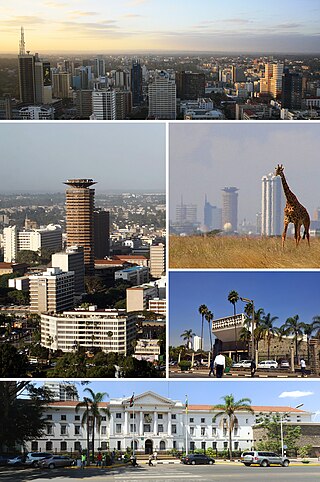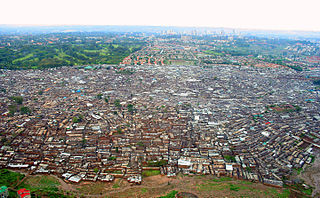Related Research Articles

Nairobi is the capital and largest city of Kenya. The name is derived from the Maasai phrase Enkare Nairobi, which translates to 'place of cool waters', a reference to the Nairobi River which flows through the city. The city proper had a population of 4,397,073 in the 2019 census. The city is commonly referred to as The Green City in the Sun.

Kibera is a division of Nairobi Area, Kenya, and neighbourhood of the city of Nairobi, 6.6 kilometres (4.1 mi) from the city centre. Kibera is the largest slum in Nairobi, and the largest urban slum in Africa. The 2009 Kenya Population and Housing Census reports Kibera's population as 170,070, contrary to previous estimates of one or two million people. Other sources suggest the total Kibera population may be 500,000 to well over 1,000,000 depending on which slums are included in defining Kibera.
Raila is a part of Kibera slum in Nairobi. Other parts of Kibera include Laini Saba, Lindi, Makina, Kianda, Gatwekera, Soweto East, Kichinjio, Kisumu Ndogo, Makongeni and Mashimoni.

Hot Sun Foundation is a non-profit organization that works in Nairobi, Kenya with young people from urban slums and other marginalized communities of East Africa to train and expose their talents and potential on the world stage. Hot Sun Foundation trains youth in all aspects of filmmaking, from scriptwriting, camera, sound, pre production, budgeting, production, directing, editing, and marketing. Vision of Hot Sun Foundation: Social transformation through art and media Mission of Hot Sun Foundation: Identify and develop youth talent to tell their stories on film
Laini Saba is a slum of Nairobi, the capital of Kenya. It belongs to the major slum of Kibera. As for Lindi, another village within Kibera, its population is estimated at 100,000. Soweto East is another village belonging to Kibera. The price of water there clearly is above Nairobi average. A Laini Saba Primary School exists.
Lindi is a suburb of Nairobi, the capital of Kenya. It belongs to the major slum of Kibera. As for Laini Saba, another village within Kibera, its population is estimated at 100,000. Soweto East is another village belonging to Kibera. The price of water there clearly is above Nairobi average. A Lindi Friends Primary School exists.
Soweto East is a part of major Kibera slum in Nairobi. A school KidStar Academy is in Soweto West. Other parts of Kibera include Soweto East, Laini Saba Lindi, Makina, Kianda, Mashimoni, Gatuikira, Kisumu Ndogo and Siranga.
Gatwekera (Gatuikira) is a part of Kibera slum in Nairobi. Its population likely exceeds 70,000. Water & Sanitation for the Urban Poor is active there. Many of its residents are Luo. Médecins Sans Frontières used to run a health center there. Other parts of Kibera include Laini Saba, Lindi, Makina, Kianda, Mashimoni, Soweto East, Kisumu Ndogo and Siranga.
Kisumu Ndogo is a name given to "villages" that are part of two informal settlements in Nairobi, Kenya, Kibera and Korogocho. Kisumu Ndogo means little Kisumu. Most dwellers of these villages are believed to be of low income. Nowadays, there are many villages across the country called Kisumu Ndogo. for example, there are in fact two Kisumu Ndogo villages in Kilifi county alone, one in Malindi sub county and one in Kilifi North sub county. There is also one in Mombasa and Nakuru Counties.
Mashimoni is a part of Kibera slum in Nairobi. Mashimoni Primary School, Facing the Future School, Mashimoni Good Samaritan School for the Orphans (MAGOSO) and Mashimoni Squatters Schools exist. Many of its residents are Luhyas and Kambas. It is part of Langata Constituency. Other parts of Kibera include Laini Saba, Lindi, Makina, Kianda, Gatwekera, Soweto East, Kisumu Ndogo and Siranga.
Siranga is a part of Kibera slum in Nairobi. Its population is estimated at 150,000 residents. The Nairobi Christian Outreach Centre is in Siranga. Other parts of Kibera include Laini Saba, Lindi, Makina, Kianda, Gatwekera, Soweto East, Kisumu Ndogo, Mugumoini, Makongeni, Kichinjio and Mashimoni.
Mugumoini is a part of Kibera slum in Nairobi. A Mugumoini Primary School exists. It is part of Langata Constituency. Many residents are Luhyas. Mugumoini has a PCEA church. Other parts of Kibera include Laini Saba, Lindi, Makina, Kianda, Gatwekera, Soweto East, Kisumu Ndogo, Makongeni, Kichinjio and Mashimoni.
Kichinjio is a part of Kibera slum in Nairobi. Kichinjio has a New Adventure Secondary School and a Kicoshep Primary School. Furthermore, Kichinjio has a mosque. Other parts of Kibera include Laini Saba, Lindi, Makina, Kianda, Gatwekera, Soweto East, Kisumu Ndogo, Makongeni and Mashimoni.
Kambi Muru is a part of Kibera slum in Nairobi. It borders to Mashimoni, Lindi, Kisumu Ndogo and Makina. Kambi Muru is the site of Kibera Academy. It is also a part of the area of Christ the King Catholic Church. Other parts of Kibera include Laini Saba, Lindi, Makina, Kianda, Gatwekera, Soweto East, Kichinjio, Kisumu Ndogo, Makongeni and Mashimoni.
Sarang'ombe is a part of Kibera in Nairobi.Some parts of Sarang'ombe ward include Ayany Estate. It is part of Kibra Constituency. An Ushirika Health Centre is in Sarang'ombe. Other parts of Kibera include Laini Saba, Lindi, Makina, Kianda, Gatwekera, Soweto East, Kichinjio, Kisumu Ndogo, Makongeni and Mashimoni.
Shilanga is a part of Kibera slum in Nairobi. It has at least one church. It has a major Luo population. Other parts of Kibera include Laini Saba, Lindi, Makina, Kianda, Gatwekera, Soweto East, Kichinjio, Kisumu Ndogo, Makongeni and Mashimoni.
Kibra Constituency is an electoral constituency in Nairobi, one of 17 constituencies in the county, and has an area of 12.1 km². It is located to the southwest of the City of Nairobi, and includes most of the Kibera slum and adjoining estates. The constituency was created prior to the 2013 general election.
Kayole is a low-income neighbourhood in the city of Nairobi. Located within the larger Eastlands area of Nairobi, it is approximately 11 kilometres (6.8 mi) east of the central business district.
Nyayo Highrise is a residential neighbourhood in the city of Nairobi. It is approximately 3.5 kilometres (2.2 mi) southwest of the central business district of Nairobi. Initially a slum upgrading project, the estate was built in an effort by the national government to provide its citizens with affordable housing.
References
- 1 2 3 Kagiri, Eva Muthoni (2008). Using Sustainable Technology to Upgrade Sanitation Case Study: Soweto East, Kibera (PDF) (Master's thesis). University of Jyväskylä. urn: nbn:fi:jyu-200901201029 .
- ↑ Amnesty International (2009). Kenya: The Unseen Majority: Nairobi's Two Million Slum-Dwellers. London: Amnesty International Publications. Retrieved 2016-12-04.